Sensitometric Velocimetry
Andrew Davidhazy
Imaging and Photographic Technology
School of Photo Arts and Sciences
Rochester Institute of Technology
Andrew Davidhazy
Imaging and Photographic Technology
School of Photo Arts and Sciences
Rochester Institute of Technology
There are many techniques by which the velocity of a particular subject can be determined. This is probably one of the least widespread methods but one may have an application in specific instances.
Sensitometric velocimetry is based on the fact that the exposure time of a given photograph does not necessarily give the same exposure time with respect to the photosensitive surface for components of the overall image.
Assume for a moment that one selects an exposure time of 1 second for a photograph. In the scene there is a stationary white subject. Maybe a white card. Upon processing the resulting image of the card will be reproduced as a certain level of density in a negative or print. Or some digital value in a digital system.
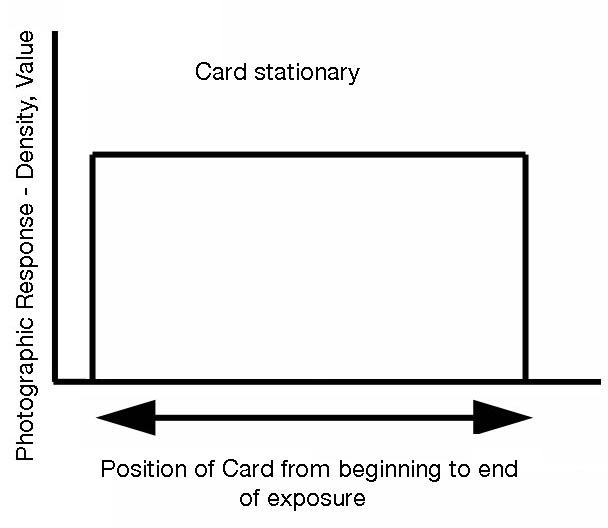
However, assume now that 2 exposures of ½ second each are made of the subject on the same photosensitive surface but the white card is moved so it occupies different locations in the image plane. When this record is processed the white card will no longer have the density that it had when it remained in the same spot for the duration of the 1 second exposure. It will be less dense.
The degree to which it loses density is a direct result of the difference in local exposure time even though the total exposure time for the scene was the same. In photographic terms the density it reaches will be that associated with a 1 stop loss of exposure.
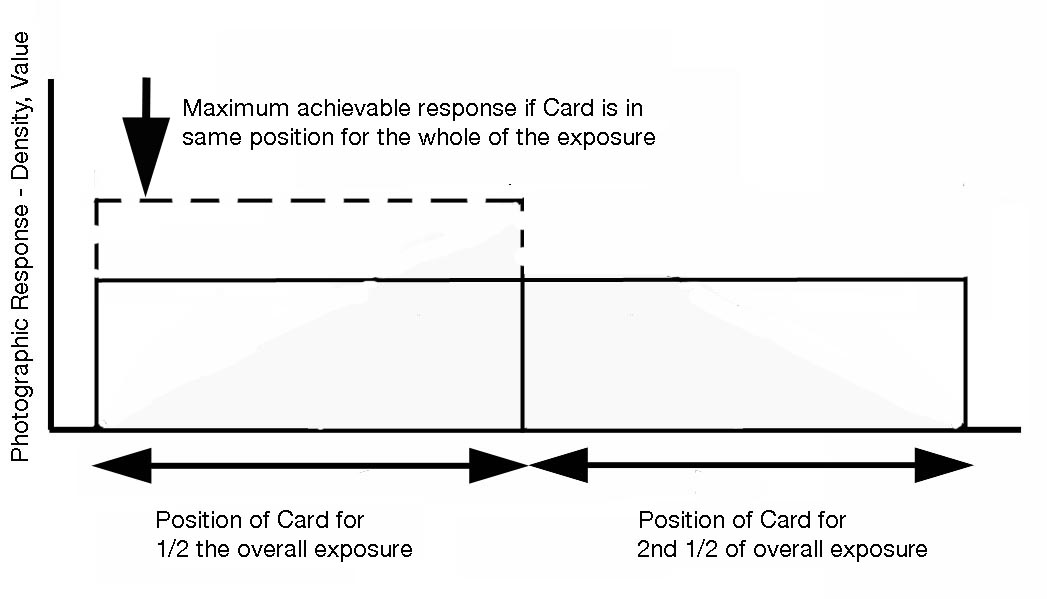
All of this assumes, of course, that a series of exposures will produce the same photographic effect as a single one equal to the addition of the individual ones delivered sequentially.
Going further we can set up a situation in such a manner that the white card will move during the time the overall exposure is given. In this first case the card will move a short distance during the time the shutter is open. Let’s say ½ of its length. What kind of photographic response might we expect in this case?
The answer to the question is that if we monitor photographic response from the edge that the card appears to be moving away from, then this will gradually increase until reaching the maximum ½ way into the image record associated with a still image of the card. The other edge of the response, on the other hand, decreases in value from that maximum to a minimum at the far edge of the record. This can best be seen in the graph below.
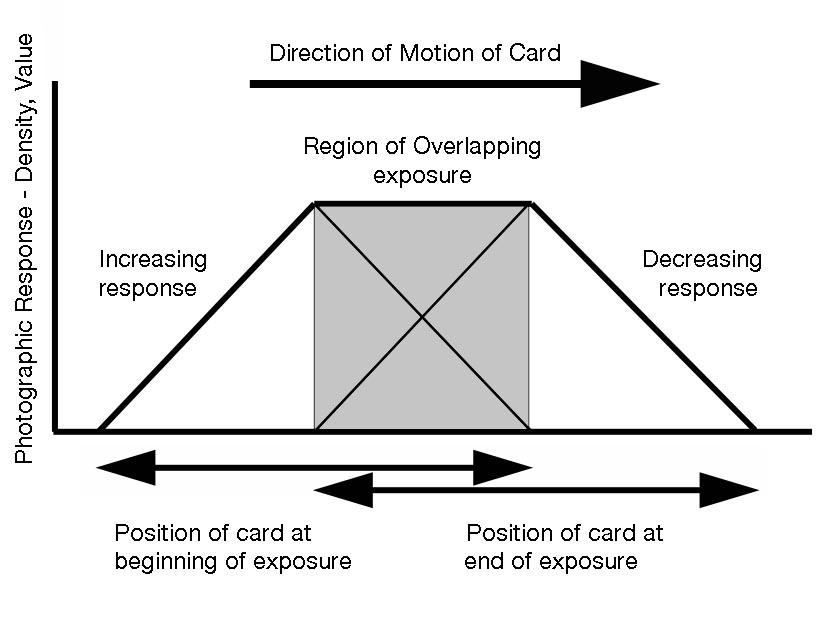
In terms of photographic response the opposite is the case with the leading edge. The length of time that the leading edge is located at the farthest point of the record is also very brief for no sooner does the leading edge reach its destination the shutter terminates the exposure. Therefore the response there is also very small. In between the response falls gradually.
What if the situation is such that the card moves a distance exactly equal to its own length during the time the shutter is open? In that case the region of overlapping exposure becomes very small (in fact it would be a single line in width!) and it is flanked by gradually increasing response on one side, the “incoming” side, and gradually decreasing response on the other side.
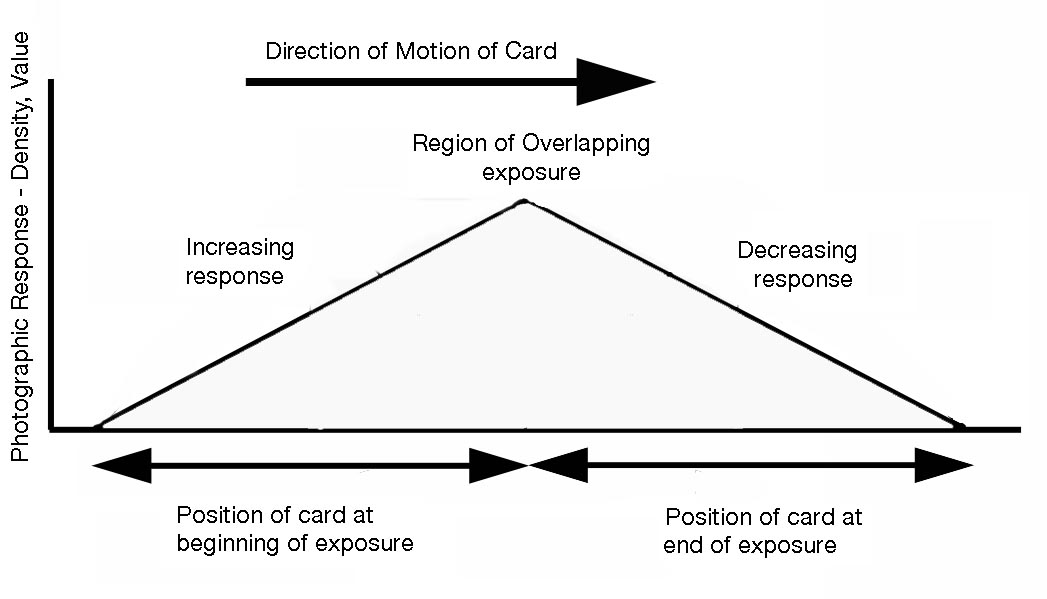
The slopes of the regions of increasing and decreasing signal may be straight lines but more than likely they will be influenced by the sensitometric characteristics of the photosensitive material used to record the image. Note that the single line of overlap has achieved the same level of response that the whole of the card achieved when it was standing still. This is associated with a local exposure time of 1 second. This is the maximum response achievable by this system.
If the card moves a distance that is greater than its own width then the maximum signal level can not obtained. This is due to the fact that even thought the overall exposure is 1 second the local exposure time never reaches the 1 second mark.
The indication is that increasing local time of exposure produces an increase in signal level up to a maximum governed by the length of time the image of the card adds light to areas of the image that other areas of the card have already exposed.
In effect, the object becomes its own shutter in a manner of speaking. In addition, the maximum photographic response achieved is now a function of the time it takes a subject to travel its own dimension in the direction it is moving.
In sensitometric velocimetry, then, we first calibrate the system by photographic a stationary subject whose velocity we want to determine later, by photographing it over a number of exposure times and a fixed aperture. This determines for us the maximum photographic response associated with a given exposure time.
This information provides us with the data needed to later examine a blurred record of the subject while it is moving. Areas of the record where it has a high response indicate the subject was traveling slowly. Where the record is faint indicates the subject was traveling quickly.
But how slowly or quickly?
All we need to do is to find a match between the response measured from the blurred record of the moving subject and match it to one of the calibrated responses or densities where the subject was stationary. We can then say that at a particular spot, where the response or density of the moving image matches the response of the stationary image, that the subject was traveling at a rate equal to its real length divided by the exposure time associated with the stationary exposure.
I am including below an idealized experimental procedure that allows us to determine the velocity of a moving target based on the density or digital value produced by the same subject while standing still and photographed at different exposure times. These exposures serve as calibration benchmarks.
When these are compared to the trace left by the subject moving at a constant velocity it is seen that the digital value of the trace is about the same as that which the subject produced while it was standing still and an exposure time of 1/15 second was used. The subject therefore must have been moving at a rate roughly equal to 15 inches per second because at this velocity it its surface would have covered the same spot of the sensor for 1/15 second.
Going further, if the subject is accelerating, then all we need to do is to find the equivalent value on the graded exposure (due to shorter and shorter effective exposure times as the subject increases velocity) to that of the calibrated images made of the staionary subject. This indicates the rate at which the subject was moving at those spots on the trace left by the accelerating subject.
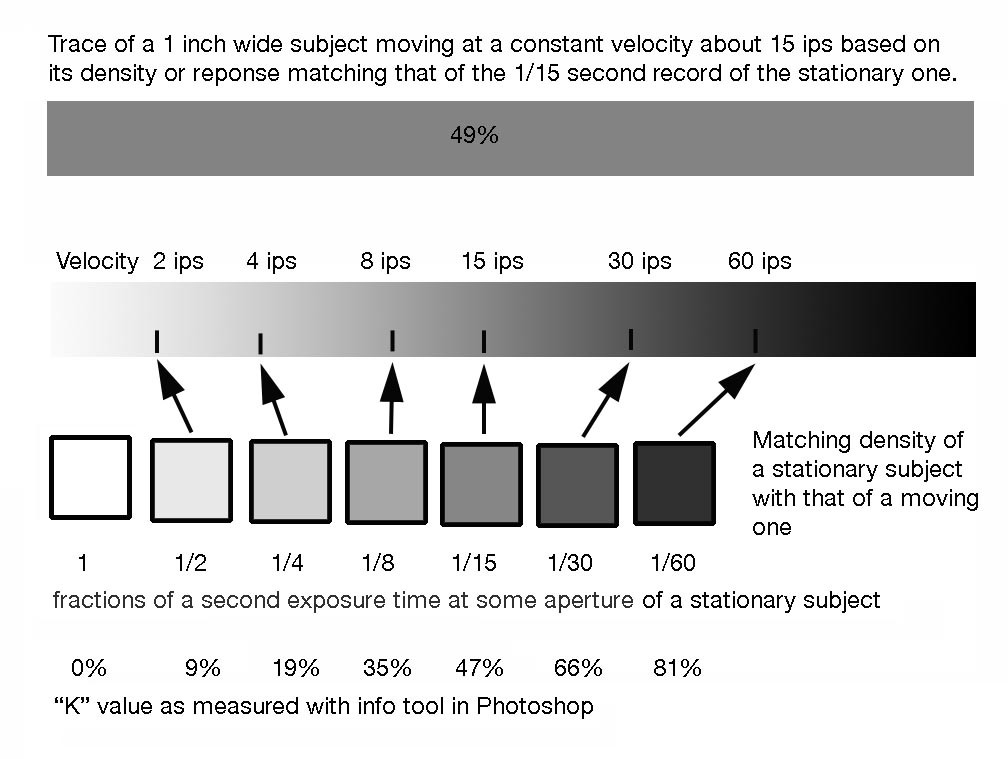
Anyway, if you read this far and you think there is "something" here and you'd like me to finish this article dealing with the "background" problem and including a real-life example, drop me a line either with a request that I do so or send me helpful hints or constructive comments about this seldom (if ever) practiced method of determining the velocity of certain subjects.
You can send me email at: Andrew Davidhazy
- andpph@rit.edu